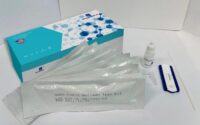Dyes found in 90% of foods have harmful effect on gut: study
Trust your gut – synthetic food dyes could be bad for you.
A new study from Cornell and Binghamton University researchers adds evidence to recent theories that common food dyes, which give your favorite supermarket snacks and confections their vibrant colors, are doing damage to your digestive system.
Food colorants such as Red 40, Yellow 5 and Yellow 6 can be found in a majority of products in the US – 90%, to be strikingly exact.
While it may seem obvious to some that items such as candies, cakes and other sweet treats contain dyes to boost their aesthetic appeal, food coloring can be found in a variety of products, including flavored drinks, chips, cereals and even over-the-counter medications.
“We found that specific nanoparticles — titanium dioxide and silicon dioxide — ordinarily used in food may negatively affect intestinal functionality,” senior author Elad Tako, who is also an associate professor of food science at Cornell, said in a statement. “They have a negative effect on key digestive and absorptive proteins.”

The study, published in the journal Antioxidants, used “human-relevant doses” — an amount comparable to what ordinary people might consume — of titanium dioxide and silicon dioxide in a lab test involving chicken eggs, which simulated a comparable response to that of a human.
Researchers injected the food dye nanoparticles into the eggs and, upon hatching, found cellular-level changes in the animals’ blood and intestines. Their findings suggest such dyes could have a similar impact on humans.
While the discovery is concerning, experts aren’t sounding alarm bells just yet – Tako admitted more research is needed before society swears off food coloring.

“We are consuming these nanoparticles on a daily basis,” said Tako. “We don’t really know how much we consume; we don’t really know the long-term effects of this consumption.”
Past data suggests that humans consume food coloring, specifically Red 40, in higher concentrations than the Food and Drug Administration advises — up to “two to three times the FDA’s accepted daily intake,” according to one doctor’s report.
FDA guidance states that synthetic food dye intake should not exceed more than 3.2 milligrams per pound of the consumer’s body weight; however, the amount of dye used in any given product can be difficult to ascertain without digging into the research.
A study from late last year yielded “alarming” results about the effects of Red 40 — sometimes called Allura red — on the human digestive tract. Researchers from McMaster University in Ontario, Canada claimed the synthetic dye could potentially trigger irritable bowel and Crohn’s diseases, after observing the biomarkers of damage in the gut cells of mice.

“The literature suggests that the consumption of Allura Red [40] also affects certain allergies, immune disorders and behavioral problems in children, such as attention deficit hyperactivity disorder (ADHD),” said the study’s author Waliul Khan in a statement.
Food dyes have also been known to cause allergies. Although rare, Red 40, Yellow 5 and Yellow 6 – the three most common synthetic colors – are the most likely to prompt a reaction.


